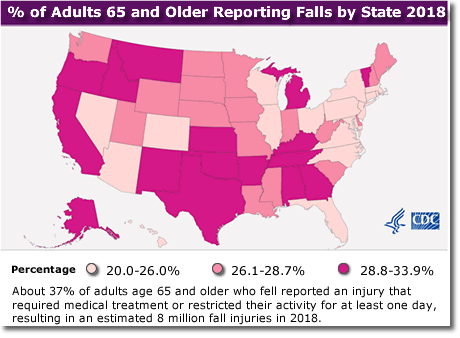 Community falls
Community fallsFalls are a significant health risk in homes, communities and healthcare facilities. Education to reduce falls is needed for all individuals, particularly those 65 and overs. Currently, approximately one-third of people over 65, fall every year (Sherrington, et al., 2019). Falls occur in all states but there is variability. In Vermont, for example, 33% of older adults fell in 2018 while in New York 26% fell.
Click the CDC map to view the actual number of falls and deaths from falls by state.
According to Choi et al. (2019) approximately one-third of older adults who received medical attention for fall injuries had an ED visit alone. Less that a fifth had an overnight hospital stay. The data was obtained from the 2013–2017 US National Health Interview Survey files of 1840 patients over 60 years of age. Patients with lung disease and memory issues were associated with just an ED visit while patients with hip and head injuries, facial injuries and other bone fractures were likely to stay longer in a hospital.
Inpatient falls
 Inpatient falls are a significant cause of hospital acquired conditions. The 2018 updated report by the Agency for Healthcare Research and Quality estimates that 700,000 to one million patients fall in U.S. hospitals each year. About 33% of the falls result in injuries with 11,000 resulting in death. https://www.ahrq.gov/professionals/systems/
Inpatient falls are a significant cause of hospital acquired conditions. The 2018 updated report by the Agency for Healthcare Research and Quality estimates that 700,000 to one million patients fall in U.S. hospitals each year. About 33% of the falls result in injuries with 11,000 resulting in death. https://www.ahrq.gov/professionals/systems/
hospital/fallpxtoolkit/index.html.
According to AHRQ, approximately 50% of nursing home residents fall every year. It is estimated that 1 in 3 of those who fall will fall two or more times in a year. One in every 10 residents who fall will experience a related severe injury. About 65,00 patients suffer hip fractures in a year. Of those falls, 1,800 nursing home residents result in deaths. https://www.ahrq.gov/patient-safety/settings/long-term-care/resource/injuries/fallspx/man1.html.
 A study by Staggs found patient characteristics, Hospital nursing unit characteristics, hospital culture, environment, equipment, and procedures influenced the rate of patient falls. Fall rates ranged from 0.2 to 13.3 falls per 1,000 patient days in medical nursing units. They classified these units as low and high-fall units. A significant difference between the low and high-fall rate units was found to be the patient turnover rates. High-fall rate units had higher patient turnover rates. They found that more time was spent by nursing personnel on admissions and discharges. Those units with higher patient turnover rates tended to be physically larger with increased distance between nursing stations and patient rooms. Hospitals with greater than 300 beds were found to have a 6% lower fall rate than smaller hospitals (Staggs et al., 2015).
A study by Staggs found patient characteristics, Hospital nursing unit characteristics, hospital culture, environment, equipment, and procedures influenced the rate of patient falls. Fall rates ranged from 0.2 to 13.3 falls per 1,000 patient days in medical nursing units. They classified these units as low and high-fall units. A significant difference between the low and high-fall rate units was found to be the patient turnover rates. High-fall rate units had higher patient turnover rates. They found that more time was spent by nursing personnel on admissions and discharges. Those units with higher patient turnover rates tended to be physically larger with increased distance between nursing stations and patient rooms. Hospitals with greater than 300 beds were found to have a 6% lower fall rate than smaller hospitals (Staggs et al., 2015).
A study of 8915 units using 2008 statistics reported the following fall rates by unit type:
Of the patients who fall, 3% to 20% will sustain an injury, 6% to 44% of those injuries are severe, such as fractures, subdural hematomas, excessive bleeding, all of which can lead to death. Even minor injuries can cause a delay in recovery (Oliver et al., 2010). Not only are the patient, family, and community affected by falls, but everyone bears the expense of rising healthcare and hospital costs.
Increased hospital costs can vary depending on the extent of injury from a fall: one hospital fall without severe damage has been shown to increase costs by $3500; two or more falls without serious injury can lead to a $16,500 increase in cost; falls with a severe injury can cost an additional $27,000 (Wu et al., 2010).
The Joint Commission continues to review hospital standards for preventing falls. A description of their recommendation for fall prevention is discussed later in this course (JCAHO, 2015). http://www.jointcommission.org/assets/1/18/SEA_55.pdf)
This course introduces the scope of this patient safety risk and recommendations about fall prevention.
Instant Feedback:
The community fall rate for persons 65 years and older is about 30%.
References
Choi, N.G., Choi, B.Y., DiNitto, D.M. et al. Fall-related emergency department visits and hospitalizations among community-dwelling older adults: examination of health problems and injury characteristics. BMC Geriatr 19, 303 (2019). https://doi.org/10.1186/s12877-019-1329-2
He, J., Dunton, N., Staggs, V. (2012). Unit-level time trends in inpatient fall rates of US hospitals. Med Care., 50(9), 801-7.
Oliver, D., Healey, F., & Haines, T.P. (2010). Preventing falls and fall-related injuries in hospitals. Clin Geriatr Med. 26(4),645-92.
Sherrington, C., Fairhall, N. J., Wallbank, G. K., Tiedemann, A., Michaleff, Z. A., Howard, K., Clemson, L., Hopewell, S., & Lamb, S. E. (2019). Exercise for preventing falls in older people living in the community. The Cochrane database of systematic reviews, 1(1), CD012424. https://doi.org/10.1002/14651858.CD012424.pub2
Staggs, V.S., Mion, L.C. & Shorr, R.I. (2015).Consistent differences in medical unit fall rates: implications for research and practice. J Am Geriatr Soc., 63(5), 983-7.
Wu, S., Keeler, E. B., Rubenstein, L.Z., Maglione, M. A. & Shekelle, P. G. (2010). A cost-effectiveness analysis of a proposed national falls prevention program. Clin Geriatr Med., 26(4),751-66.
©RnCeus.com